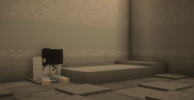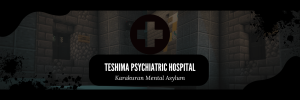PREFACE
The Tokyo Prefecture of Izu-Karakura, has for the span of its lengthy history, housed an abundance of cruelty that is unknown to the majority of its populus. A hunger for power and greed has been deeply seeded into many aspects of its secluded plain. Save for a few files, stowed away for the sake of privacy, most affairs are left up to speculation. Yet there comes a rare opportunity in which information is released as a means to serve justice to the suffering inflicted upon victims. In 2010, several years after the foreclosure of the Teshima Psychiatric Hospital, a variety of documents were released to the public, revealing an abhorrent extortion of government funds and malpractice. The following are detailed accounts confirmed through patient files, administrative action, and investigation done by Karakura’s government and police department.
DOCUMENT ONEHISTORY OF TESHIMA PSYCHIATRIC HOSPITAL
Taisho and Early Showa Period (1912-1945)
. . .
After several violent incidents involving these unstable residents, the policies of the Seishinbyōin Hō were adopted in 1926. Slowly, an abandoned warehouse left to collect dust was transitioned, with the scarce resources available, into a makeshift asylum. The disordered individuals were gathered and assessed by doctors to determine if they were a risk to society. If the label of lunatic was legally stamped to their file, there was little that could be done to reverse the status, until the asylum itself decided they were well enough to be released. In 1931, the first director, Eito Teshima, was appointed to oversee the practices of the makeshift hospital. Later down the line the asylum would be named after the director and his family due to their conceived contribution. The first few years of the practice were no short of exhausting, overwhelmed by an amount of patients that far exceeded that of the staff. Resources in the medical and personnel department were difficult to obtain as the war raged on overseas. Though by nothing short of a miracle, and several shortcuts, they persevered. Patient care suffered greatly, without much knowledge of mental illnesses, and as the era came to an end, it seemed evident further difficulty would arise.
The Otori Corruption (1945-1956)
. . .

Such changes however, could not hold a candle to the legal and moral dilemma that would soon follow. An era of political turmoil encompassed Karakura as Tetsuya Otori took the position of mayor in 1946. Protesters and adversaries of the Otori name took to the streets to oust the brewing corruption, which prompted Tetsuya to silence them by any means necessary. A proposition was imposed soon after through private means, forged from a shared object of power and wealth. Eito Teshima agreed to institutionalize anyone Otori deemed as a threat, painting a false narrative of psychosis and in exchange, Otori would fund the efforts of the Director. For the entire length of Tetsuya’s mayoral term, and several years preceding it, more than twenty individuals were falsely institutionalized. Otori’s contributions paved the way for a more modernized asylum. With a more extensive outreach, Teshima was able to bring more individuals into the custody of the mental hospital, as well as keep them for longer. The sole purpose of the Director’s efforts centered around quantity. Patient wellness became directly oppositional to the objective that produced the largest funding from the state. The least was given to those they were meant to be saving, even the staff found struggle in getting by with such minimal resources.
As a rapid decline in ethical practice took place, the few who knew of the patients who resided in Teshima became aware something was amiss. The vast majority of those institutionalized, were either mandated by court order, or placed there by their families. Of the families who turned them over, less than 10 percent regularly inquired about their wellbeing, in part due to the taboo associated with mental illness. In 1950, the hospital was sued over deficient medical care of a young woman, [REDACTED]. It was stated by her attorney that they regularly withheld food and other amenities to obtain her cooperation. There were also signs of physical and verbal abuse that the family picked up on during their visits with her. In the end the hospital was cited as not liable and the woman was transferred by her family to a mainland facility. Just a year after the legal case, Director Eito Teshima retired. He covered his embezzlement efforts through pulling several strings in his last few months within the position. Eito instituted his own son, Heiichirō Teshima, as the succeeding Director. No one batted an eye as the cruelty continued with the next generation. Despite the Otori corruption coming to an end, Teshima’s inhumane practices had only begun.
Itsbyoshi Rise (1956-1964)
. . .
Heiichirō Teshima, unlike his father, had never wanted to be a practicing physician of any kind. Though when the opportunity for wealth had dangled itself in front of him, he took it with little argument. 1956 hosted the more detrimental staff change ever implemented, when the new Director realized the opportunities his father had not. In hiring out more part time positions, he could cut employee expenses by nearly one-third. This guaranteed an unconsidered consequence, less pay made staff less observant and considerate, leaving patients with an unstable environment in which nurses and doctors ignored their individual needs. Physical violence became a standard practice for handling uncooperative or distressed persons. Social deprivation, targeted insults and a lack of patience made the living conditions insufferable. As tensions escalated, the ethical lines began to blur further, procedures and excess medical sedation left many neurologically inept, unable to defend themselves in any capacity. The Director turned a blind eye to it all, as he focused on what to pawn next at the expense of those under his care.

In 1958 the Karakuran government adopted yet another mainland law, the Kokumin-Kenko-Hoken Ho, which guaranteed health insurance for all Karakurans. This only served to secure the funds the Teshima Psychiatric hospital received, in turn disincentivizing wellness of patients. Two major incidents occurred following this installation. The first happened during the year of 1960, in which the head nurse of Teshima was severely injured during a physical altercation with a patient. Although the origin of the interaction isn’t completely confirmed, it was speculated that the nurse had made several comments and threatening gestures that upset the patient, a man in his 40s. By the time the remaining staff were able to successfully separate the two, the nurse had received several broken bones and a permanent spinal injury; she later retired due to health concerns. The second incident, one of which only came to light after the foreclosure of Teshima, resulted in the death of five patients. The cause was cited as improper dosage of medication by one of the part-time employees. Although this was an unusually deadly incident, it was far from the first time a patient had passed due to unsuitable care. These occurrences were small glimpses of the many shortcomings of inadequate financial backing by the Teshima family.
Educational Boom - Westernization (1964-2010)
. . .

An investigation into Teshima Psychiatric Hospital was opened in 1985, only four months after Director Ayabe’s hiring. Although some documentation had been burned, a vast majority was left for officials to dissect. The detailed accounts of the cruelty and mistreatment began to unfurl with staff reports, administrative action, and even eye-witness testimony from multiple long term patients. After four grueling years, in 1989 Teshima Psychiatric Hospital was legally foreclosed on account of malpractice. The site was deemed a safety hazard once the investigation had closed. In total 47 people, 2 of which were staff, had passed away and over 110 major injuries had occurred within its walls. The patients that remained were transferred to mental hospitals within mainland Japan. As for Heiichirō Teshima, in 1991, during the Teshima V. Government of Karakura case, he was found guilty on all charges. For his crimes, he was given a sentence of ten years within prison, of which he served nearly in full before his death in 2004.
The remaining years soon warped the abandoned psychiatric hospital into an attraction for urban exploration. Ghost stories written by Karakuran students served to create fear mongering amongst residents. The space was repurposed, the heinous history was brushed under the rug and forgotten in filing cabinets once more. It wasn’t until 2010, when a petition was made by two families who had lost loved ones to the tragedy, did the documents resurface. Desiring justice for the shortcomings of Teshima and the Karakuran government, legal action forced the hand of those involved. Finally, after so many years in the dark, a statement of apology was released to the families affected, and some of the records of what had occurred were released to the public. Yet it could never ratify the inhumane cruelty that Teshima allowed to flow seamlessly by like water under a bridge. Though the asylum has long gone, and most don’t recall the names of those who passed, decades of agony still stain the ground below the weeping floorboards.
DOCUMENT TWO
LETTERS OF KAGOME INDOU
PREFACE
The following contains several of thirdy letters written by patient Kagome Indou during her time at Teshima Psychiatric Hospital. These letters were never sent to the recipient, instead they were placed in Kagome’s patient file due to her family requesting no contact. Her status as a patient was marked as permanent, until her death in 1964. The file detailed that she had been receiving an improper dosage of schizophrenia medication over a prolonged period of time. All names have been redacted for privacy reasons.
DATE - 16/1/1955
WRITER - Kagome Indou
RECIPIENT - [REDACTED]
Dear Mom,
I miss you. The nurses said I could write a letter and you’d receive it soon. Most of the time I can’t recall how long I’ve been here, so I’m sorry if it's too soon to write to you. It's just really lonely, some of the other people here are genuinely off putting, so I don’t have anyone to talk to. Would you please visit me soon, maybe you could bring [REDACTED] with you as well? I keep having this feeling like someone’s watching me but maybe it's just my imagination. Please write back and tell me when you can visit. I know you’re busy, so take your time, I love you.
~Sincerely Kagome
DATE - 22/8/1957
WRITER - Kagome Indou
RECIPIENT - [REDACTED]
Dear [REDACTED],
The staff are the same as always. Nurse [REDACTED] yelled at me when I asked for a nightlight. The hallucinations have been getting far worse as of late, especially when I’m in the dark. Three days ago, Nurse [REDACTED] said I was being a baby and needed to grow up. I get treated like a child here and I’m sick of it, just because I have issues they think I’m somehow inferior to them? I feel so frustrated, the nurses keep insulting me and when I raise my voice to defend myself, my meals are reduced. I think the medication is helping, but I feel really dizzy and my mouth is horribly dry. I know no one wants to visit me, but if you could write to the Director to tell him the nurses are being unfair I’d really appreciate it.
~Sincerely Kagome
DATE - 5/2/1958
WRITER - Kagome Indou
RECIPIENT - [REDACTED]
Dear [REDACTED],
I saw one of the nurses and [REDACTED] fight today. He was screaming really loudly and the nurse insulted him and said she didn’t get paid enough. She threw a metal tray at the wall before storming out. The noise was so loud my ears were ringing the rest of the day. This isn’t the first time I’ve seen something like this. The doctors aren’t much better either. I don’t understand why things have to be this way, I wish I could just leave. I know I can’t because the doctors have to agree I’m well enough, but I wish they would treat us nicer. The director has to sign off on a release as well, but I’ve never seen him before and I’ve been here for nearly three years. Maybe he’s just some wives' tale they tell us patients to behave. I remember when I thought it was just going to be a few weeks, why did I think that? I’m also really tired of being restrained so often, if they get tired of us they just put us in the white room and strap us down. The whispers get really loud when there’s no one around to distract me.
~Sincerely Kagome
DATE - 6/12/1963
WRITER - Kagome Indou
RECIPIENT - [REDACTED]
Dear [REDACTED],
I’m tired of seeing the hallucination of a dark figure that stands behind the nurses. It keeps taunting me and telling me that I’m no good. The nurses don’t seem to care either, one of them said that I’m making it up for attention. I miss nurse [REDACTED], I think she got fired. She was the only one who actually believed me. A week ago I attacked what I thought was the dark figure and I got smacked for it because it was actually nurse [REDACTED]. I don’t think she’s coming back, her arm looked broken. They put me in the white room after hitting me around. I wish someone would believe me, I didn’t mean to hurt her, I was scared. I guess it's stupid to write letters no one replies to, I hope you still read them though. I want to go somewhere different, somewhere that treats me like a human being. I’m not a monster, I may see them from time to time, but that doesn’t make me one.
~Sincerely Kagome
 DATE - ???
DATE - ???WRITER - ???
RECIPIENT - ???
Dear Mom,
The nurses abandoned me. Now they’re watching me. There’s too many eyes and I can’t hide from them. I think they’re real. I feel so tired, but I’m too scared to go to sleep. The white room makes them stand out and if I close my eyes they get closer. [INCOHERENT WRITING], so I’m confused. The nurses don’t come to visit me. Why? What did I do? I don’t want to be alone anymore. I feel sick. It's getting worse. Come visit. Please. No one understands. I’m scared. Help me. If I don’t leave soon, I think that maybe [INCOHERENT WRITING]. You told me this place would fix me, but now there’s more of them. It's so loud! I didn’t mean to hurt [REDACTED], she looked like one of them. All I see is them and the white room, how long have I been here? Mom why does no one care? Maybe they’re right, maybe I am crazy, but I don’t want to live like this anymore. [INCOHERENT WRITING] please?
~Kagome
DOCUMENT THREE
TESHIMA V. GOVERNMENT OF KARAKURA

New developments revealed in court today following the last day of the Teshima V. Government of Karakura case. This comes nearly three years after the foreclosure of the Teshima Psychiatric Hospital in 1989. The investigation into the Teshima family and their apparent embezzlement of funds has begun to raise questions amongst residents about the competence of government officials and the concerning reality of healthcare. One of the lead investigators of the case said in a statement that “we are committed to bringing closures to the families who have been affected. The outcome of this trial has shown the dedication of all those who put countless hours into finding the truth of this multi- decade long affair.”
Former Director Heiichirō Teshima was found guilty on all charges relating to malpractice, theft, embezzlement of government funds, and destruction of government property. He has been sentenced to serve a total of 10 years within a detention center in Kyoto, Japan. At the age of 68 several Teshima sympathizers claim such a harsh sentence is a cruel punishment for someone considered elderly. Though many others argue that regardless of age, Former Director Teshima knowingly withheld a good quality of life from hundreds of patients over the course of his career.
Documentation used today in court reveals the harrowing ordeals faced by patients as well as staff eye-witnessed reports detailing how they “got by” with the lack of resources. Regardless of your viewpoint, one thing is for certain, health care for the mentally ill will not be handled in the same manner as before. Teshima Psychiatric Hospital may very well be the only one of its kind, as officials claim they will be sending those claimed mentally unfit for society to mainland facilities. Only time will tell what the future of Karakura psychiatric health care entails.
. . .
Important Information - If you or anyone you know has been affected by Teshima Psychiatric Hospital you may be entitled to compensation. Please report any and all incidents to the KPD, the town hall building or call #360-269-4598.
Former Director Heiichirō Teshima was found guilty on all charges relating to malpractice, theft, embezzlement of government funds, and destruction of government property. He has been sentenced to serve a total of 10 years within a detention center in Kyoto, Japan. At the age of 68 several Teshima sympathizers claim such a harsh sentence is a cruel punishment for someone considered elderly. Though many others argue that regardless of age, Former Director Teshima knowingly withheld a good quality of life from hundreds of patients over the course of his career.
Documentation used today in court reveals the harrowing ordeals faced by patients as well as staff eye-witnessed reports detailing how they “got by” with the lack of resources. Regardless of your viewpoint, one thing is for certain, health care for the mentally ill will not be handled in the same manner as before. Teshima Psychiatric Hospital may very well be the only one of its kind, as officials claim they will be sending those claimed mentally unfit for society to mainland facilities. Only time will tell what the future of Karakura psychiatric health care entails.
. . .
Important Information - If you or anyone you know has been affected by Teshima Psychiatric Hospital you may be entitled to compensation. Please report any and all incidents to the KPD, the town hall building or call #360-269-4598.

